北师大版(2019)高中英语必修第二册 Unit6The admirable>Lesson 1 A Medical Pioneer公开课件(共34张PPT)
文档属性
| 名称 | 北师大版(2019)高中英语必修第二册 Unit6The admirable>Lesson 1 A Medical Pioneer公开课件(共34张PPT) | 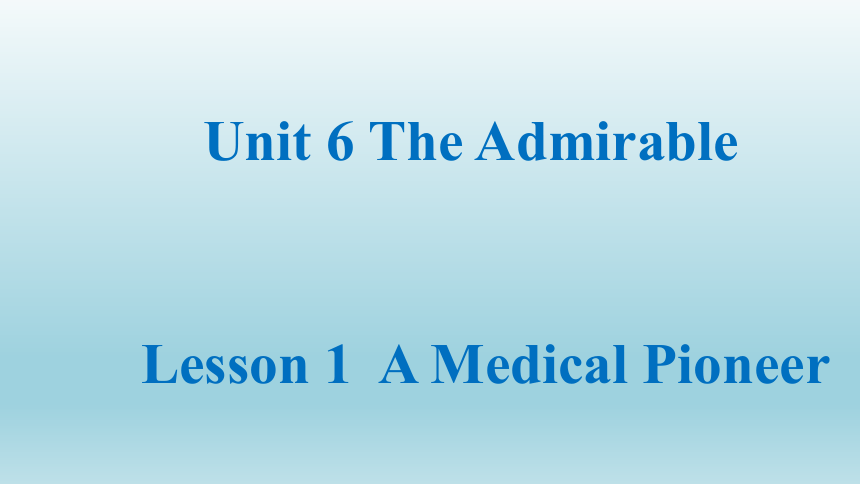 | |
| 格式 | pptx | ||
| 文件大小 | 1.4MB | ||
| 资源类型 | 教案 | ||
| 版本资源 | 北师大版(2019) | ||
| 科目 | 英语 | ||
| 更新时间 | 2023-03-07 18:24:30 | ||
图片预览

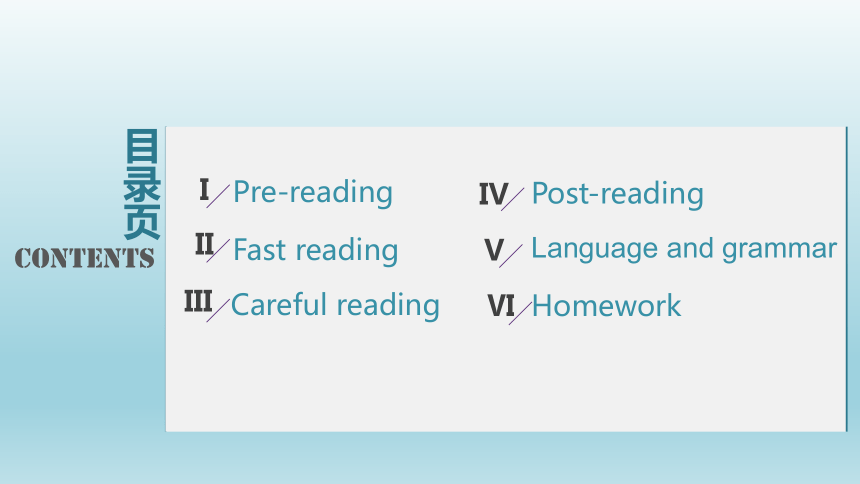
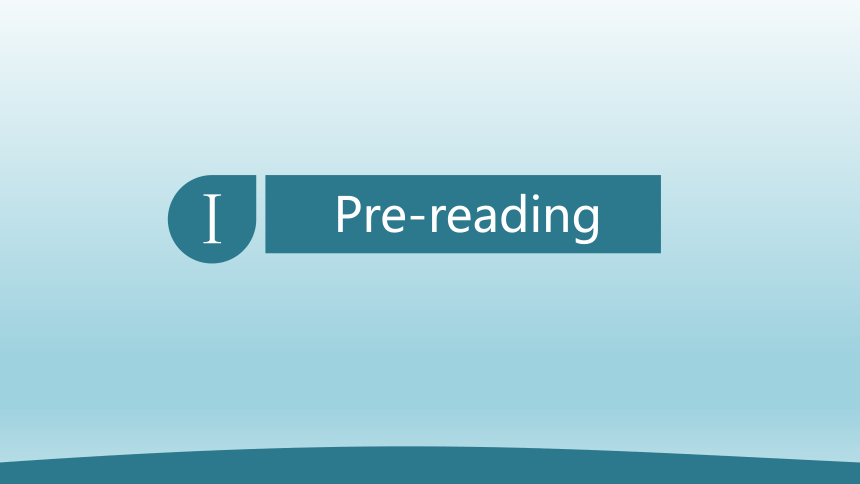
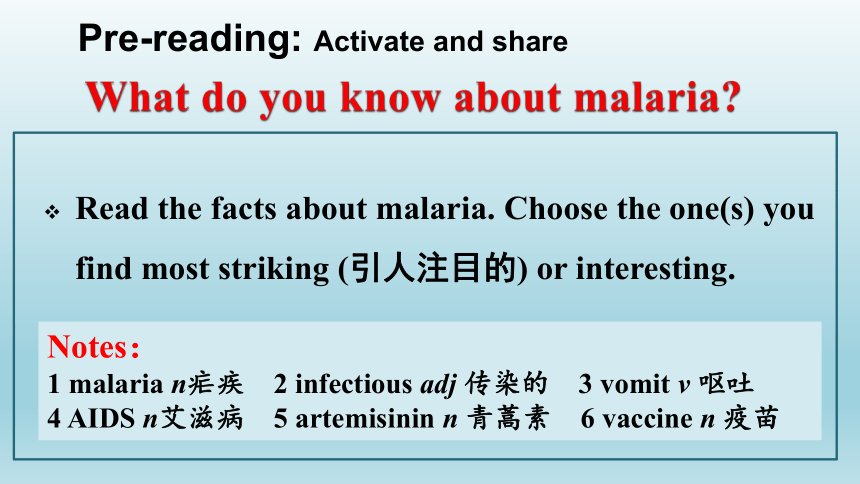
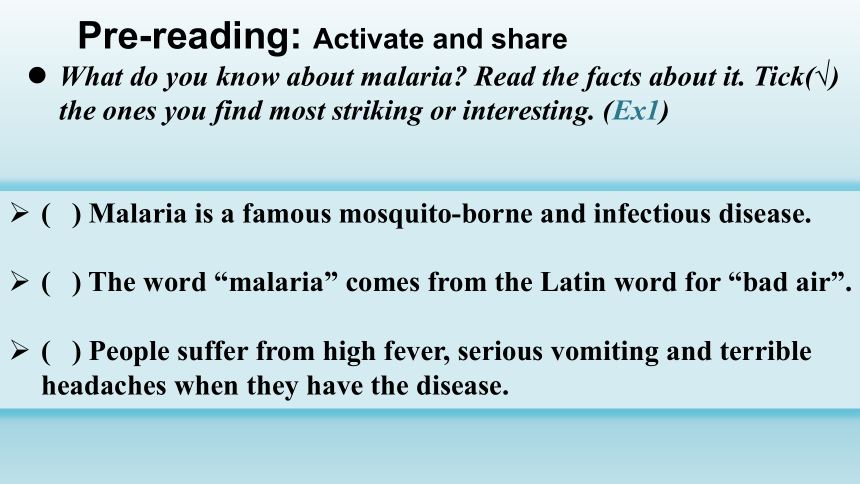

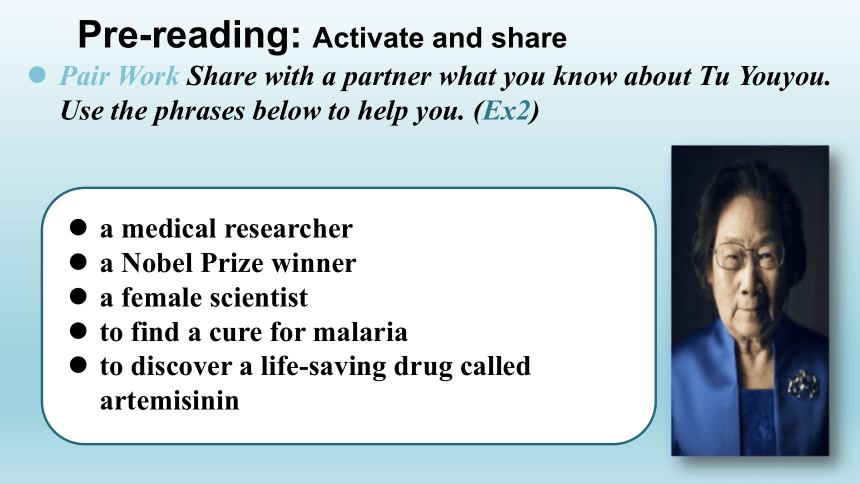

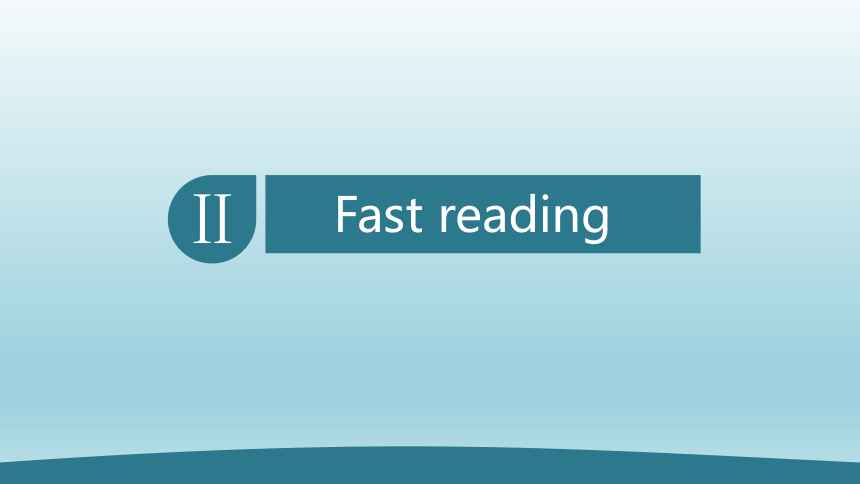
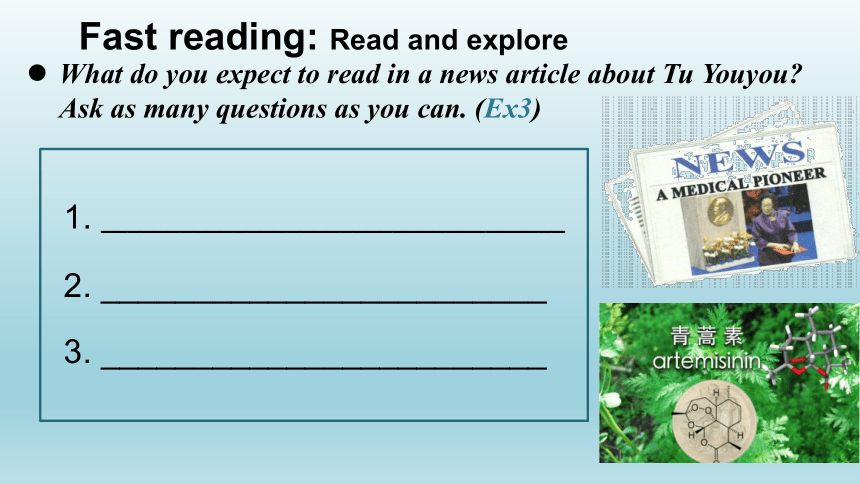
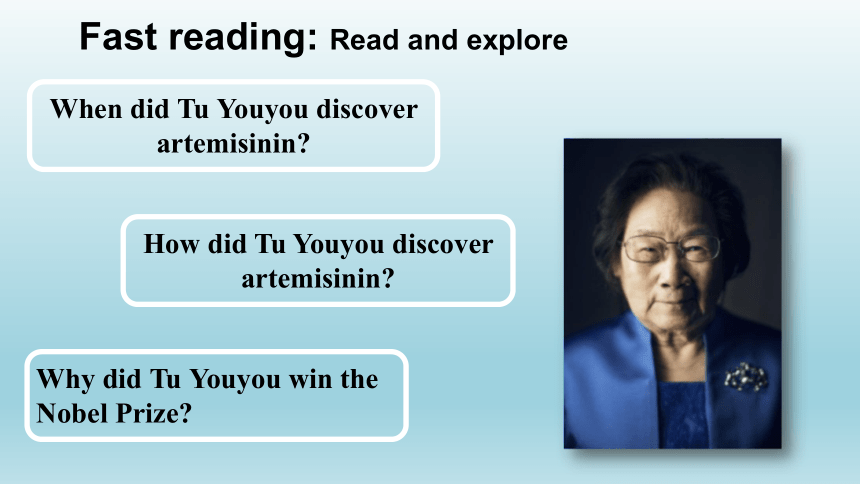
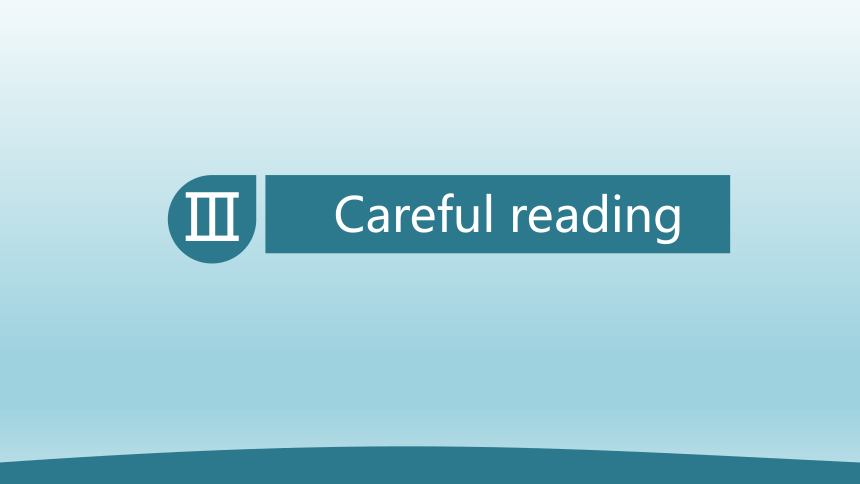
文档简介
(共34张PPT)
Unit 6 The Admirable
Lesson 1 A Medical Pioneer
目录页
contents
Pre-reading
I
Post-reading
IV
Fast reading
II
Language and grammar
V
III
Careful reading
Ⅵ
Homework
Ⅰ
Pre-reading
Pre-reading: Activate and share
What do you know about malaria
Read the facts about malaria. Choose the one(s) you find most striking (引人注目的) or interesting.
Notes:
1 malaria n疟疾 2 infectious adj 传染的 3 vomit v 呕吐
4 AIDS n艾滋病 5 artemisinin n 青蒿素 6 vaccine n 疫苗
Pre-reading: Activate and share
What do you know about malaria Read the facts about it. Tick(√) the ones you find most striking or interesting. (Ex1)
( ) Malaria is a famous mosquito-borne and infectious disease.
( ) The word “malaria” comes from the Latin word for “bad air”.
( ) People suffer from high fever, serious vomiting and terrible headaches when they have the disease.
Pre-reading: Activate and share
What do you know about malaria Read the facts about it. Tick(√) the ones you find most striking or interesting. (Ex1)
( ) Malaria kills over 1,000,000 people a year — more people than any disease apart from AIDS.
( ) The drug with artemisinin has proved to be the most effective cure.
( ) There is currently no effective vaccine against malaria.
Pre-reading: Activate and share
Pair Work Share with a partner what you know about Tu Youyou. Use the phrases below to help you. (Ex2)
a medical researcher
a Nobel Prize winner
a female scientist
to find a cure for malaria
to discover a life-saving drug called artemisinin
Pre-reading: Activate and share
pioneer: one of the first people to do something, whose work or ideas are later developed by other people.
Ⅱ
Fast reading
Fast reading: Read and explore
What do you expect to read in a news article about Tu Youyou Ask as many questions as you can. (Ex3)
1. ___________________________________
2. ________________________
3. ________________________
Fast reading: Read and explore
When did Tu Youyou discover artemisinin
Why did Tu Youyou win the Nobel Prize
How did Tu Youyou discover artemisinin
Ⅲ
Careful reading
Careful reading: Read and explore
Read and complete the following information. Then introduce Tu Youyou to your partner based on what you have written. (Ex5)
Basic information
Scientific work
Attitudes
Basic information
Date of birth:
______________________________________
Birthplace:
______________________________________
Education:
______________________________________
30 December, 1930
Zhejiang Province
Studying medicine at Peking University
Scientific work
Task and difficulties:
______________________________________________________________________________________________________________________________
Research:
______________________________________________________________________________________________________________________________
Discovery: _______________________________
Task is to find a cure for malaria.
Difficulties are limited resources, not enough staff and poor working conditions.
1. tested more than 240,000 chemicals
2. researched hundreds of traditional recipes
3. tested herself
artemisinin
Attitudes
Towards the honour:
________________________________________
Towards future research:
________________________________________
________________________________________
Not interested in fame
Feels it’s a recognition and motivation for all scientists in China
Careful reading: Read and explore
Draw a line to match the words and phrases in columns A and B. Then use the phrases to talk about Tu Youyou’s work and achievement. (Ex6)
A
B
study
establish
find
research
use
have
come across
discover
be awarded
a cure
hundreds of traditional recipes
Chinese medicine
limited resources
a team
a promising chemical
modern research methods
a Nobel Prize
artemisinin
Ⅳ
Post-reading
Post-reading: Read and explore
Use three words or phrases to summarise Tu Youyou’s personal quality. Give your reasons and find evidence from the text. (Ex7)
Dedicating to science / Devoted to research
Brave
Creative
Post-reading: Read and explore
Group Work Think and share. (Ex8)
1. Why is Tu Youyou considered a medical pioneer
2. What typical writing features can you identify in the news article about Tu Youyou
Tu Youyou is considered a medical pioneer because she discovered a cure for malaria which no one else had discovered.
The headline is short and interesting.
The introduction summarises Tu Youyou’s background.
The body provides details on her research.
Quotes and photographs are included.
Ⅴ
Language and grammar
Focus on Language: Difficult and key words
Review:
1. malaria n 疟疾 2. infectious adj 传染的
3. vomit v 呕吐 4. AIDS n 艾滋病
5. artemisinin n 青蒿素 6. vaccine n 疫苗
effect n 效果;作用
effective adj 有效的
effectively adv 有效地
have effects / an effect on
put / bring / carry sth into effect
come / go into effect
in effect
take effect
be of no effect
Focus on Language: Difficult and key words
对……有影响
把某物投入使用 / 实行
开始生效;开始实施
其实,实际上
生效,起作用
无效
limit vt 限定;限制
n 界限;边界;限度
limit ... to ...
set a limit to / on
within the limits of
within limits
without limit
limited adj
be limited to sth
Focus on Language: Difficult and key words
把……限定在……范围内
对……规定限度
在……范围内
在一定范围内;有限度地
无限地
有限的
受制于某物
Focus on Language: Difficult sentence-1
A scientist who was on the Nobel Prize Committee called Hans Forssberg explained that “the discovery of artemisinin has led to the development of new drugs which have saved the lives of millions”.
科学家汉斯·福斯伯格是一位诺贝尔奖评审委员会成员,他解释说:“ 青蒿素的发现带动了新药的开发,拯救了数百万人的生命。”
解析:who和which均引导定语从句,分别修饰scientist和drugs,called为过去分词作后置定语。that 引导宾语从句。
Page53
The reason why this was difficult was that the team had limited resources.
这之所以困难,是因为团队的资源有限。
Focus on Language: Difficult sentence-2
解析:why 引导定语从句,修饰reason。that引导表语从句。
Page53
Focus on Grammar: Relative Clauses(3)
Tick the sentences that include a relative clause. Underline the clauses.
( )1. A scientist who was on the Nobel Prize Committee called Hans Forssberg explained that …
( )2. When thanking the Committee for the honour, Tu Youyou said, “This is not only an honour for myself, but also recognition and encouragement for all scientists in China.”
( )3. In 1969, Tu Youyou was chosen to establish a team whose goal was to find a cure for malaria …
( )4. The reason why this was difficult was that the team had limited resources.
√
√
√
______________________
______
_________________
____________
Circle the words that are used to join the sentences together.
1. Later, she studied Chinese medicine for two and a half years with experts in the field from whom she gained a deep knowledge about traditional practices.
2. They did not have enough staff, and the laboratory in which they worked had poor air quality.
Focus on Grammar: Relative Clauses(3)
“介词+关系代词”引导的定语从句一般多用于正式用语中,既可引导限制性定语从句,又可引导非限制性定语从句。
Who is the man with whom you just shook hands
The two things about which Karl Max was not sure were the grammar and some of the idioms.
Focus on Grammar: Relative Clauses(3)
注意:
“介词+关系代词”引导的定语从句中,选择正确的介词时可参考如下几个原则:
(1)根据后面动词和介词的搭配关系选择;
(2)根据与前面名词的搭配关系选择;
(3)有时需同时考虑动词和介词的搭配关系及介词和名词的搭配关系;
(4)根据所要表达的意思来确定。
Focus on Grammar: Relative Clauses(3)
Focus on Grammar: Exercise
Join the pairs of sentences using relative pronouns.
1. David is my friend. I often play tennis with him.
2. He has 20 books. Only two of them are interesting.
3. This is quite an interesting job. I really want to apply for it.
David is my friend with whom I often play tennis.
He has 20 books, only two of which are interesting.
This is quite an interesting job for which I really want to apply.
Ⅵ
Homework
Homework
Write a passage about a well-known scientist. And try your best to use some relative clauses.
THANKS!
Unit 6 The Admirable
Lesson 1 A Medical Pioneer
目录页
contents
Pre-reading
I
Post-reading
IV
Fast reading
II
Language and grammar
V
III
Careful reading
Ⅵ
Homework
Ⅰ
Pre-reading
Pre-reading: Activate and share
What do you know about malaria
Read the facts about malaria. Choose the one(s) you find most striking (引人注目的) or interesting.
Notes:
1 malaria n疟疾 2 infectious adj 传染的 3 vomit v 呕吐
4 AIDS n艾滋病 5 artemisinin n 青蒿素 6 vaccine n 疫苗
Pre-reading: Activate and share
What do you know about malaria Read the facts about it. Tick(√) the ones you find most striking or interesting. (Ex1)
( ) Malaria is a famous mosquito-borne and infectious disease.
( ) The word “malaria” comes from the Latin word for “bad air”.
( ) People suffer from high fever, serious vomiting and terrible headaches when they have the disease.
Pre-reading: Activate and share
What do you know about malaria Read the facts about it. Tick(√) the ones you find most striking or interesting. (Ex1)
( ) Malaria kills over 1,000,000 people a year — more people than any disease apart from AIDS.
( ) The drug with artemisinin has proved to be the most effective cure.
( ) There is currently no effective vaccine against malaria.
Pre-reading: Activate and share
Pair Work Share with a partner what you know about Tu Youyou. Use the phrases below to help you. (Ex2)
a medical researcher
a Nobel Prize winner
a female scientist
to find a cure for malaria
to discover a life-saving drug called artemisinin
Pre-reading: Activate and share
pioneer: one of the first people to do something, whose work or ideas are later developed by other people.
Ⅱ
Fast reading
Fast reading: Read and explore
What do you expect to read in a news article about Tu Youyou Ask as many questions as you can. (Ex3)
1. ___________________________________
2. ________________________
3. ________________________
Fast reading: Read and explore
When did Tu Youyou discover artemisinin
Why did Tu Youyou win the Nobel Prize
How did Tu Youyou discover artemisinin
Ⅲ
Careful reading
Careful reading: Read and explore
Read and complete the following information. Then introduce Tu Youyou to your partner based on what you have written. (Ex5)
Basic information
Scientific work
Attitudes
Basic information
Date of birth:
______________________________________
Birthplace:
______________________________________
Education:
______________________________________
30 December, 1930
Zhejiang Province
Studying medicine at Peking University
Scientific work
Task and difficulties:
______________________________________________________________________________________________________________________________
Research:
______________________________________________________________________________________________________________________________
Discovery: _______________________________
Task is to find a cure for malaria.
Difficulties are limited resources, not enough staff and poor working conditions.
1. tested more than 240,000 chemicals
2. researched hundreds of traditional recipes
3. tested herself
artemisinin
Attitudes
Towards the honour:
________________________________________
Towards future research:
________________________________________
________________________________________
Not interested in fame
Feels it’s a recognition and motivation for all scientists in China
Careful reading: Read and explore
Draw a line to match the words and phrases in columns A and B. Then use the phrases to talk about Tu Youyou’s work and achievement. (Ex6)
A
B
study
establish
find
research
use
have
come across
discover
be awarded
a cure
hundreds of traditional recipes
Chinese medicine
limited resources
a team
a promising chemical
modern research methods
a Nobel Prize
artemisinin
Ⅳ
Post-reading
Post-reading: Read and explore
Use three words or phrases to summarise Tu Youyou’s personal quality. Give your reasons and find evidence from the text. (Ex7)
Dedicating to science / Devoted to research
Brave
Creative
Post-reading: Read and explore
Group Work Think and share. (Ex8)
1. Why is Tu Youyou considered a medical pioneer
2. What typical writing features can you identify in the news article about Tu Youyou
Tu Youyou is considered a medical pioneer because she discovered a cure for malaria which no one else had discovered.
The headline is short and interesting.
The introduction summarises Tu Youyou’s background.
The body provides details on her research.
Quotes and photographs are included.
Ⅴ
Language and grammar
Focus on Language: Difficult and key words
Review:
1. malaria n 疟疾 2. infectious adj 传染的
3. vomit v 呕吐 4. AIDS n 艾滋病
5. artemisinin n 青蒿素 6. vaccine n 疫苗
effect n 效果;作用
effective adj 有效的
effectively adv 有效地
have effects / an effect on
put / bring / carry sth into effect
come / go into effect
in effect
take effect
be of no effect
Focus on Language: Difficult and key words
对……有影响
把某物投入使用 / 实行
开始生效;开始实施
其实,实际上
生效,起作用
无效
limit vt 限定;限制
n 界限;边界;限度
limit ... to ...
set a limit to / on
within the limits of
within limits
without limit
limited adj
be limited to sth
Focus on Language: Difficult and key words
把……限定在……范围内
对……规定限度
在……范围内
在一定范围内;有限度地
无限地
有限的
受制于某物
Focus on Language: Difficult sentence-1
A scientist who was on the Nobel Prize Committee called Hans Forssberg explained that “the discovery of artemisinin has led to the development of new drugs which have saved the lives of millions”.
科学家汉斯·福斯伯格是一位诺贝尔奖评审委员会成员,他解释说:“ 青蒿素的发现带动了新药的开发,拯救了数百万人的生命。”
解析:who和which均引导定语从句,分别修饰scientist和drugs,called为过去分词作后置定语。that 引导宾语从句。
Page53
The reason why this was difficult was that the team had limited resources.
这之所以困难,是因为团队的资源有限。
Focus on Language: Difficult sentence-2
解析:why 引导定语从句,修饰reason。that引导表语从句。
Page53
Focus on Grammar: Relative Clauses(3)
Tick the sentences that include a relative clause. Underline the clauses.
( )1. A scientist who was on the Nobel Prize Committee called Hans Forssberg explained that …
( )2. When thanking the Committee for the honour, Tu Youyou said, “This is not only an honour for myself, but also recognition and encouragement for all scientists in China.”
( )3. In 1969, Tu Youyou was chosen to establish a team whose goal was to find a cure for malaria …
( )4. The reason why this was difficult was that the team had limited resources.
√
√
√
______________________
______
_________________
____________
Circle the words that are used to join the sentences together.
1. Later, she studied Chinese medicine for two and a half years with experts in the field from whom she gained a deep knowledge about traditional practices.
2. They did not have enough staff, and the laboratory in which they worked had poor air quality.
Focus on Grammar: Relative Clauses(3)
“介词+关系代词”引导的定语从句一般多用于正式用语中,既可引导限制性定语从句,又可引导非限制性定语从句。
Who is the man with whom you just shook hands
The two things about which Karl Max was not sure were the grammar and some of the idioms.
Focus on Grammar: Relative Clauses(3)
注意:
“介词+关系代词”引导的定语从句中,选择正确的介词时可参考如下几个原则:
(1)根据后面动词和介词的搭配关系选择;
(2)根据与前面名词的搭配关系选择;
(3)有时需同时考虑动词和介词的搭配关系及介词和名词的搭配关系;
(4)根据所要表达的意思来确定。
Focus on Grammar: Relative Clauses(3)
Focus on Grammar: Exercise
Join the pairs of sentences using relative pronouns.
1. David is my friend. I often play tennis with him.
2. He has 20 books. Only two of them are interesting.
3. This is quite an interesting job. I really want to apply for it.
David is my friend with whom I often play tennis.
He has 20 books, only two of which are interesting.
This is quite an interesting job for which I really want to apply.
Ⅵ
Homework
Homework
Write a passage about a well-known scientist. And try your best to use some relative clauses.
THANKS!
同课章节目录
- Unit 4 Information technology
- Lesson 1 Avatars
- Lesson 2 Apps
- Lesson 3 Internet and Friendships
- Unit 5 Humans and nature
- Lesson 1 A Sea Story
- Lesson 2 Professional Rescue Team
- Lesson 3 Race to the Pole
- Unit 6 The admirable
- Lesson 1 A Medical Pioneer
- Lesson 2 History Makers
- Lesson 3 The Superhero Behind Superman
